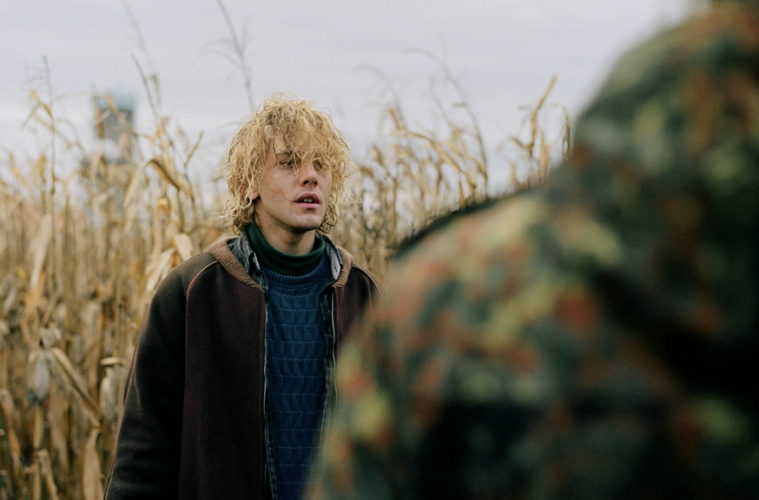
Interiors is an online film and architecture publication, published by Mehruss Jon Ahi and Armen Karaoghlanian. For more information, visit their website and official store.
Xavier Dolan’s film, Tom at the Farm, like Michel Marc Bouchard’s play, depends largely on its setting of Québec’s rural panorama. The film starts by taking its audience out of the city and into the country, as we follow – quite literally – Tom (Dolan) into the farm via an aerial shot of his car.
This opening scene of the Saint-Blaise-sur-Richelieu is 25 miles (40 kilometers) south of Montreal, Tom’s place of residence and employment. This lengthy drive immediately emphasizes the distance of the farm from the outside world.
The difference, however, between film and play is how individual spaces are represented; rather than restricting the space like the source material, which consists only of a kitchen, a barn, and a bedroom, Dolan opens his film up. In the press book, he states a desire for removing Tom from the farm a handful of times. These include scenes at the funeral, his visit to the doctor, and a trip to a bar. In these instances, we see Tom interacting with characters other than Francis (Pierre-Yves Cardinal) and his mother Agathe (Lise Roy); more importantly, we see him continuously coming back to the farm, further suggesting his consenting captivity.
In Dolan’s first three feature films, his characters’ sexuality always played a key focal point of the narrative. In I Killed My Mother, he plays the role of a conflicted homosexual teenager; in Heartbeats, he plays one-third of a love dual who becomes infatuated with the same man; in Laurence Anyways (which does not feature the writer-director in an acting capacity), his focus shifted onto a larger scale, focusing on the epic love story of a man who decides he wants to live the rest of his life as a woman. Tom at the Farm, which is a change of direction for the filmmaker in terms of both style and content, is more subtle in its exploration of such themes. The character of Tom isn’t explicitly stated as a homosexual; even his reason for attending Guillaume’s funeral is slowly unraveled.
Tom at the Farm is a film that deals with oppression and deception. Francis, on the surface, comes off as Guillaume’s homophobic, domineering brother who wishes to run Tom out of their home. Dolan, however, has said that they are both “wounded” individuals. Francis has known nothing his whole life, save for their family farm, and, since becoming head of the household after the death of his father, has been burdened with the responsibility of looking after his family. Francis, in essence, has been and always will be alone. Tom experiences a different kind of loneliness: the sort that derives from living in the city.
This film carefully examines the relationship between Tom and Francis, with each finding something in one another. Tom remarks that Francis reminds him of his lover, citing similarities in their voices, whereas Francis — who we learn is more or less sexually deprived — asserts physical dominance over the weaker Tom. This feeling of claustrophobia is amplified with a shift in aspect ratios, which happens twice over the course of the film.
Tom at the Farm borders on the perverse as a clear sexual tension rests between Tom and Francis. In his arrival at the farm, Tom enters an abusive relationship. Francis psychologically manipulates Tom, showing signs of Stockholm Syndrome as he starts sympathizing with his captor. Tom even starts repeating Francis’ words, and later, when Francis chokes him, Tom pushes him for more.
Their sexual dynamic coheres in a beautifully unexpected scene in which Tom and Francis dance together in a barn. In our floor plan, we diagrammed their dance, highlighting three key moments, including its beginning (1), Francis dipping Tom (2), and Francis shutting the music off when his mother walks in (3).
Francis’ advances become more direct over the course of the film. In a scene where Tom wakes up, he finds that Francis has pushed their beds together, suggesting the intimacy he desires. Francis also even states, “I know you like me,” urging Tom not to leave the farm. Francis very clearly sees Tom as a submissive partner — whether Francis had a similar type of relationship with his younger brother is never addressed or revealed.
Tom at the Farm is also a film that is very much concerned with exploring a continuous cycle of abuse. Sarah’s arrival highlights how brainwashed Tom has become. Tom, who desperately wanted to escape the farm earlier in the film, now considers Francis part of his family and even threatens Sarah when she wants to leave. It’s through her character that we see how manipulative Francis has been. It’s not until much later, when Tom hears the brutal story about Francis in the bar, that he finally awakens, which encourages his escape — but not before Sarah becomes Francis’ new victim.

Tom at the Farm hits theaters and VOD on August 14.


